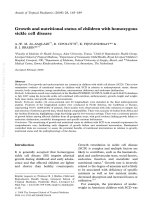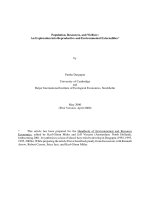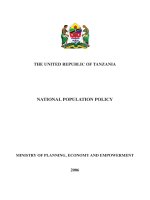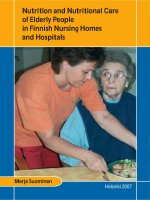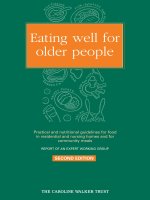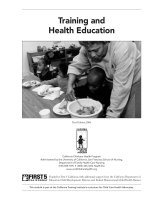Food and Nutritional Toxicology pptx
Bạn đang xem bản rút gọn của tài liệu. Xem và tải ngay bản đầy đủ của tài liệu tại đây (7.55 MB, 308 trang )
CRC PR ESS
Boca Raton London New York Washington, D.C.
Stan ley T. Omaye
Food and
Nutritional
Toxicology
© 2004 by CRC Press LLC
This book contains information obtained from authentic and highly regarded sources. Reprinted material
is quoted with permission, and sources are indicated. A wide variety of references are listed. Reasonable
efforts have been made to publish reliable data and information, but the author and the publisher cannot
assume responsibility for the validity of all materials or for the consequences of their use.
Neither this book nor any part may be reproduced or transmitted in any form or by any means, electronic
or mechanical, including photocopying, microfilming, and recording, or by any information storage or
retrieval system, without prior permission in writing from the publisher.
The consent of CRC Press LLC does not extend to copying for general distribution, for promotion, for
creating new works, or for resale. Specific permission must be obtained in writing from CRC Press LLC
for such copying.
Direct all inquiries to CRC Press LLC, 2000 N.W. Corporate Blvd., Boca Raton, Florida 33431.
Trademark Notice:
Product or corporate names may be trademarks or registered trademarks, and are
used only for identification and explanation, without intent to infringe.
Visit the CRC Press Web site at www.crcpress.com
© 2004 by CRC Press LLC
No claim to original U.S. Government works
International Standard Book Number 1-58716-071-4
Library of Congress Card Number 2003065211
Printed in the United States of America 1 2 3 4 5 6 7 8 9 0
Printed on acid-free paper
Library of Congress Cataloging-in-Publication Data
Omaye, Stanley T.
Food and nutritional toxicology / Stanley T. Omaye.
p. ; cm.
Includes bibliographical references and index.
ISBN 1-58716-071-4
1. Food—Toxicology. I. Title.
[DNLM: 1. Food—adverse effects. 2. Food Additives—adverse effects. 3. Food
Analysis—methods. 4. Food Contamination. 5. Food Hypersensitivity. 6. Food Poisoning.
WA 701 O54f 2004]
RA1258.O46 2004
615.9
¢
54—dc22 2003065211
TX714_C00.fm Page 4 Wednesday, January 21, 2004 8:06 AM
© 2004 by CRC Press LLC
Preface
Food can be defined as the nutritive material taken into an organism for growth,
work, or repair and for maintaining the vital processes. Food sustains life, and, as
such, many individuals view food as an uncomplicated, pure source of nutrition.
Therefore, such individuals are often bewildered to learn that food is comprised of
an array of natural chemicals, and not all the chemicals are nutrients or enhance
nutritive value, but in fact may decrease nutritional value or, worse still, are toxic
(e.g., naturally occurring toxicants). Also, chemicals can be added to food, either
intentionally or unintentionally, during production and processing. Cooking, storing,
and preparing food in our kitchens create new components and different chemical
compounds, which may have a toxic effect, an improvement or enhancement effect,
or no effect at all on the meal quality.
Food and nutritional toxicology is the field devoted to studying the complexity
of the chemicals in food, particularly those that have the potential of producing
adverse health effects. One begins to appreciate the complexity of the field when
one recognizes that food chemicals can interact with body fluids and other compo-
nents of the diet and that such interactions may have a multitude of effects, beneficial
or harmful. For example, the endogenous secretions of the stomach have the ability
to inactivate or break down many chemicals; however, chemicals such as nitrate can
be reduced to nitrite, which has the potential of reacting with proteins in the stomach
to produce carcinogenic nitrosamines. This may be inconsequential if vitamin C or
E is present in the stomach, because of its capacity to inhibit the nitrosation process.
Thus, interactions between food components and other chemicals are complicated
but have dire implications as regards health and adverse effects.
Overall, because of the diversity of the field, food and nutritional toxicology
spans a number of disciplines, such as nutrition, toxicology, epidemiology, food
science, environmental health, biochemistry, and physiology. The field includes
studies of human health impacts of food containing environmental contaminants or
natural toxicants. The field includes investigations of food additives, migration of
chemicals from packaging materials into foods, and persistence of feed and food
contaminants in food products. Also, the field covers examining the impact of
contaminants on nutrient utilization, adverse effects of nutrient excesses, metabolism
of food toxicants, and the relationship of the body’s biological defense mechanisms
to such toxicants. Finally, because the study of food and nutritional toxicology has
obvious societal implication, one must examine the risk determination process, how
food is regulated to ensure safety, and the current status of regulatory processes.
This book is intended as a text for advanced undergraduate or graduate students
in nutrition, food sciences, environment, or toxicology, and professionals in the areas
of nutrition, environmental health and sciences, and life or health and medical
sciences. The objective of this text is to present an in-depth study of toxicants found
TX714_C00.fm Page 5 Wednesday, January 21, 2004 8:06 AM
© 2004 by CRC Press LLC
in foods by (1) providing the general principles of toxicology, including methods
for food safety assessment and biochemical and physiological mechanisms of action
of food toxicants; (2) developing an understanding of foodborne intoxications and
infections and of diseases linked to foods; (3) applying the principles to the preven-
tion of foodborne disease; and (4) providing a background about the regulation of
food safety.
For nearly a decade, I have been working with students, in and out of the
classroom, on many facets of this evolving area of toxicology. This textbook has
evolved from my experiences while conducting a course on food and nutritional
toxicology and is designed to be a teaching tool.
Stanley T. Omaye
TX714_C00.fm Page 6 Wednesday, January 21, 2004 8:06 AM
© 2004 by CRC Press LLC
Acknowledgments
This book is dedicated to students of food and nutritional toxicology — past, present,
and future. Special thanks go to C.C. Bjerke for his contributions in writing Chapters
4 and 5. I am indebted to the encouragement from my mentors and colleagues and
grateful for the support and understanding of my family and friends.
TX714_C00.fm Page 7 Wednesday, January 21, 2004 8:06 AM
© 2004 by CRC Press LLC
Contents
SECTION I
Fundamental Concepts
Chapter 1
An Overview of Food and Nutritional Toxicology
Defining the Terms and Scope of Food and Nutritional Toxicology
Toxicology
Food and Nutritional Toxicology
Toxicants in Foods and Their Effects on Nutrition
Nutrients
Naturally Occurring Toxicants
Food Additives and Contaminants
Impact of Diet on the Effects of Toxicants
Study Questions and Exercises
Recommended Readings
Chapter 2
General Principles of Toxicology
Phases of Toxicological Effects
Exposure Phase
Toxicokinetic Phase
Toxicodynamic Phase
Dose–Response Relationship
Frequency Response
Potency and Toxicity
Categories of Toxicity
Reversibility of Toxicity Response
Hypersensitivity vs. Hyposensitivity
Study Questions and Exercises
Recommended Readings
Chapter 3
Factors That Influence Toxicity
Diet and Biotransformation
Effect of Macronutrient Changes
Protein
Lipids
Carbohydrates
Effect of Micronutrient Changes
Vitamins
TX714_C00.fm Page 9 Wednesday, January 21, 2004 8:06 AM
© 2004 by CRC Press LLC
Minerals
Gender and Age
Species
Study Questions and Exercises
Recommended Readings
Chapter 4
Food Safety Assessment Methods in the Laboratory: Toxicological
Testing Methods
Analysis of Toxicants in Foods
Oral Ingestion Studies
Acute Toxicity Testing
Toxicology Screen
Dose-Range-Finding and Dose–Response Curve for Lethality
Subchronic Toxicity Testing
Chronic Toxicity Testing
Genetic Toxicity
Ames Tests
Host-Mediated Assays
Eukaryotic Cells,
In Vitro
DNA Damage and Repair
Forward Mutations in Chinese Hamster Cells
Mouse Lymphoma Cell Assay
Sister Chromatid Exchanges
Eukaryotic Cells,
In Vivo
Drosophila melanogaster
Micronucleus Test
Specialized Oral Ingestion Studies
Developmental Toxicity — Teratogenesis
Reproductive
Metabolic — Toxicokinetics
Study Questions and Exercises
Recommended Readings
Chapter 5
Food Safety Assessment: Compliance with Regulations
Good Laboratory Practices (GLPs)
General Provisions: Subpart A
Section 58.1 — Scope
Organization and Personnel: Subpart B
Personnel
Testing Facility Management
Study Director
Quality Assurance Unit
Facility: Subpart C
Section 58.41 — General
TX714_C00.fm Page 10 Wednesday, January 21, 2004 8:06 AM
© 2004 by CRC Press LLC
Equipment: Subpart D
Equipment Design
Maintenance and Calibration of Equipment
Testing Facilities Operation: Subpart E
Standard Operating Procedures
Reagents and Solutions
Animal Care
Test and Control Articles: Subpart F
Test and Control Article Characterization
Test and Control Article Handling
Mixtures of Articles with Carriers
Protocol for and Conduct of a Nonclinical Laboratory Study:
Subpart G
Protocol — Section 58.120
Conduct of a Nonclinical Laboratory Study — Section 58.130
Records and Reports: Subpart J
Reporting of Nonclinical Laboratory Study Results —
Section 58.185
Storage and Retrieval of Records and Data — Section 58.190
Retention of Records — Section 58.195
Good Manufacturing Practices
Regulatory Agencies
The Food and Drug Administration
Centers for Disease Control and Prevention
U.S. Department of Agriculture
U.S. Environmental Protection Agency
Occupational Safety and Health Administration
The National Marine Fisheries Service
Local and State Agencies
International Agencies
U.S. Food Laws
Study Questions and Exercises
Recommended Readings
Chapter 6
Risk
Risk–Benefit
Hazard Identification, Dose–Response, and Exposure Assessment
Dose–Response Assessment
Exposure Assessment
Risk Characterization
Threshold Relationships
Nonthreshold Relationships
Risk Put into Perspective
Study Questions and Exercises
Recommended Readings
TX714_C00.fm Page 11 Wednesday, January 21, 2004 8:06 AM
© 2004 by CRC Press LLC
Chapter 7
Epidemiology in Food and Nutritional Toxicology
Descriptive Strategies
Ecological Studies
Case Reports
Analytical Strategies
Cross-Sectional Studies
Prospective Studies
Retrospective Studies
Meta-Analysis
Molecular Epidemiology
Exposure–Dose Studies
Physiological Studies
Gene–Environment Interactions
Foodborne Diseases and Epidemiology
Study Questions and Exercises
Recommended Readings
Chapter 8
GI Tract Physiology and Biochemistry
Anatomy and Digestive Functions
Gut Absorption and Enterocyte Metabolism
Passive Diffusion
Carrier Mediated
Endocytosis and Exocytosis
Movement of Substances across Cellular Membranes
Lipid-to-Water Partition Coefficient
Ionization and Dissociation Constants
Transport into the Circulation
Delivery of Toxicant from the Systemic Circulation to Tissues
Storage Sites
Plasma Proteins
Liver and Kidney
Bone
Lipid Depots
Physiologic Barriers to Toxicants
Fluid Balance and Diarrhea
Treatment
Study Questions and Exercises
Recommended Readings
Chapter 9
Metabolism and Excretion of Toxicants
Metabolism of Toxicants
Conversion with Intent to Excrete
Biotransformation Enzymology
Phase I or Type I Reactions
TX714_C00.fm Page 12 Wednesday, January 21, 2004 8:06 AM
© 2004 by CRC Press LLC
Reduction Reactions
Hydrolysis
Phase II or Type II Reactions
Oxidative Stress
Cellular Reductants and Antioxidants
Enzymatic Antioxidant Systems
Targets of Oxidative Stress Products
Excretion
Urinary Excretion
Biliary and Fecal Excretion
Pulmonary Gases
Other Routes of Excretion
Milk
Sweat and Saliva
Principles of Toxicokinetics
Design of a TK Study
One-Compartment TK
Volume of Distribution
Multicompartment Models
Study Questions and Exercises
Recommended Readings
Chapter 10
Food Intolerance and Allergy
Allergy and Types of Hypersensitivity
Primary Food Sensitivity
Nonimmunological Primary Food Sensitivities
Secondary Food Sensitivity
Symptoms and Diagnosis
Treatment
Study Questions and Exercises
Recommended Readings
SECTION II
Toxicants Found in Foods
Chapter 11
Bacterial Toxins
Intoxications
Bacillus cereus
Mode of Action
Clinical Symptoms
Clostridium botulinum
Mode of Action
Clinical Symptoms
TX714_C00.fm Page 13 Wednesday, January 21, 2004 8:06 AM
© 2004 by CRC Press LLC
Staphylococci
Mode of Action
Clinical Symptoms
Infections
Salmonella
Clinical Symptoms
Campylobacter jejuni
Clinical Symptoms
Clostridium perfringens
Clinical Symptoms
Escherichia coli
Enteropathogenic
Escherichia coli
(EPEC)
Enteroinvasive
Escherichia coli
(EIEC)
Enterotoxigenic
Escherichia coli
(ETEC)
Escherichia coli
O157:H7 (Enterohemorrhagic
E. coli
or
EHEC)
Listeria monocytogens
Clinical Symptoms
Shigella
Clinical Symptoms
Vibrio
Clinical Symptoms
Yersinia enterocolitica
Clinical Symptoms
Study Questions and Exercises
Recommended Readings
Chapter 12
Animal Toxins and Plant Toxicants
Marine Animals
Scombroid Poisoning
Mode of Action
Clinical Symptoms
Saxitoxin
Mode of Action
Clinical Symptoms
Pyropheophorbide-A
Mode of Action
Clinical Symptoms
Tetrodotoxin
Mode of Action
Clinical Symptoms
Ciguatoxin
Mode of Action
Clinical Signs
TX714_C00.fm Page 14 Wednesday, January 21, 2004 8:06 AM
© 2004 by CRC Press LLC
Plants
Goitrogens
Cyanogenic Glycosides
Phenolic Substances
Cholinesterase Inhibitors
Clinical Symptoms
Biogenic Amines
Clinical Symptoms
Study Questions and Exercises
Recommended Readings
Chapter 13
Fungal Mycotoxins
Ergot Alkaloids and Ergotism
Mode of Action and Clinical Symptoms
Aflatoxin
Trichothecenes
Penicillia Mycotoxins
Rubratoxin
Patulin
Yellow Rice Toxins
Other Mycotoxins
Study Questions and Exercises
Recommended Readings
Chapter 14
Toxicity of Nutrients
Macronutrients
Carbohydrates
Lipids
Protein
Micronutrients
Vitamins
Fat-Soluble Vitamins
Water-Soluble Vitamins
Minerals and Trace Elements
Magnesium
Iron
Zinc
Copper
Manganese
Selenium
Antinutrients
Antiproteins
Antiminerals
Antivitamins
TX714_C00.fm Page 15 Wednesday, January 21, 2004 8:06 AM
© 2004 by CRC Press LLC
Study Questions and Exercises
Recommended Readings
Chapter 15
Parasites, Viruses, and Prions
Protozoa
E. histolytica
Giardia lamblia
Toxoplasma gondii
Worms
Roundworms
Trichinella spiralis
Ascaris lumbricoides
Anisakids
Tapeworms
Viruses
Prions (Proteinaceous Infectious Particles)
Diagnosing for BSE
Study Questions and Exercises
Recommended Readings
SECTION III
Food Contamination and Safety
Chapter 16
Residues in Foods
Insecticides
DDT (1,1'-(2,2,2-Trichloroethylidene)bis(4-Chlorobenzene)
Organophosphates
Carbamates
Cyclodiene Insecticides
Herbicides
Chlorophenoxy Acid Esters (Phenoxyalipatic Acids)
Bipyridyliums
Fungicides
Industrial and Environmental Contaminants
Halogenated Hydrocarbons
Polychlorinated Biphenyls
Dioxins
Heavy Metals
Mercury
Lead
Cadmium
Arsenic
Study Questions and Exercises
Recommended Readings
TX714_C00.fm Page 16 Wednesday, January 21, 2004 8:06 AM
© 2004 by CRC Press LLC
Chapter 17
Food Additives, Colors, and Flavors
Preservatives
Benzoic Acid and Sodium Benzoate (Figure 17.1)
Sorbate (Figure 17.2)
Hydrogen Peroxide (Figure 17.3)
Nitrite and Nitrate
Antioxidants
Ascorbic Acid
Tocopherol
Propyl Gallate
BHT and BHA
Sweeteners
Saccharin
Sodium Cyclamate
Aspartame
Acesulfame
Sugar Alcohols
Alitame
D-Tagatose
Sucralose
Coloring Agents
Red No. 2 (Amaranth)
Red No. 3
Yellow No. 4 (Tartrazine)
Methyl Anthranilate
Safrole
Monosodium Glutamate (MSG)
Study Questions and Exercises
Recommended Readings
Chapter 18
Food Irradiation
History of Food Irradiation
Types of Irradiation
Effectiveness of Irradiation
By-Products of Irradiation
Misconceptions
Regulations
Study Questions and Exercises
Recommended Readings
Chapter 19
Polycyclic Aromatic Hydrocarbons and Other Processing
Products
Benzo(
a
)pyrene and Polycyclic Aromatic Hydrocarbons
Hetrocyclic Amines
TX714_C00.fm Page 17 Wednesday, January 21, 2004 8:06 AM
© 2004 by CRC Press LLC
Nitrates, Nitrites, and Nitrosamines
Products of the Maillard Reaction
Study Questions and Exercises
Recommended Readings
Chapter 20
Emerging Food Safety Issues in a Modern World
HACCP
Developing an HACCP Plan
Assemble the HACCP Team
Describe the Food and Its Distribution
Describe the Intended Use and Consumers of the Food
Develop a Flow Diagram Describing the Process
Verify the Flow Diagram
Principle 1: Hazard Analysis
Principle 2: Determine Critical Control Points (CCPs)
Principle 3: Establish Critical Limits for Preventive Measures
Principle 4: Establish Procedures to Monitor CCPs
Principle 5: Corrective Action When a Critical Limit Is Exceeded
Principle 6: Effective Record-Keeping Systems
Principle 7: Verify That the HAACP System Is Working
Antibiotic Resistance
Scope of the Problem
GMOs
Pest Resistance
Herbicide Tolerance
Disease Resistance
Cold Tolerance
Drought Tolerance and Salinity Tolerance
Nutrition
Pharmaceuticals
Phytoremediation
Environmental Hazards
Unintended Harm to Other Organisms
Reduced Effectiveness of Pesticides
Gene Transfer to Nontarget Species
Human Health Risks
Allergenicity
Unknown Effects on Human Health
Economic Concerns
GMO Foods and Labeling
Conclusion
Study Questions and Exercises
Recommended Readings
TX714_C00.fm Page 18 Wednesday, January 21, 2004 8:06 AM
© 2004 by CRC Press LLC
Section I
Fundamental Concepts
TX714_D01.fm Page 1 Wednesday, January 21, 2004 8:08 AM
© 2004 by CRC Press LLC
1
An Overview of Food and
Nutritional Toxicology
DEFINING THE TERMS AND SCOPE OF FOOD
AND NUTRITIONAL TOXICOLOGY
T
OXICOLOGY
In essence, toxicology is the science of poisons, toxicants, or toxins. A poison,
toxicant, or toxin is a substance capable of causing harm when administered to an
organism. Harm can be defined as seriously injuring or, ultimately, causing the death
of an organism. This is a rather simplistic definition, because virtually every known
chemical or substance has the potential for causing harm. The term
toxicant
can be
a synonym for
poison
, or the term
poison
might be more appropriate for the most
potent substances, i.e., substances that induce adverse effects at exposure levels of
a few milligrams per kilogram of body weight (see later discussion). The term
toxin
usually refers to a poison derived from a protein or conjugated protein produced by
some higher plant, animal, or pathogenic bacteria that is highly poisonous for other
living organisms, e.g., botulinum toxins. Toxicologists study the noxious or adverse
effects of substances on living organisms or on
in vitro
surrogate models, such as
cell and tissue cultures. The substances toxicologists study are usually chemical
compounds but may be elemental or complex materials. Radioactive elements, heavy
metals (e.g., mercury or lead), or the packing materials used in food processing are
examples of such substances. Food toxicology deals with substances found in food
that might be harmful to those who consume sufficient quantities of the food con-
taining such substances. On rare occasions, common foods are contaminated with
unacceptably high levels of toxicants. Such substances can be inherent toxicants,
substances naturally found in foods, or contaminants, which are substances that find
their way into food either during the preparation or processing of such foods.
Nutritional toxicology is the study of the nutritional aspects of toxicology.
Nutritional toxicology is related to and might even overlap but is not synonymous
with food toxicology. Food toxicology emphasizes toxicants or toxins found in foods,
whereas nutritional toxicology targets the interrelations that toxicants or toxins have
with nutrients in the diet, which affect nutritional status. Nutritional toxicology can
refer to the means by which the diet or components of the diet prevent against the
adverse effects of toxicants or toxins.
It is likely that the first experience humans had with toxicology was with a
toxicant found in food. The science of toxicology has been studied since antiquity,
TX714_C01.fm Page 3 Wednesday, January 21, 2004 8:09 AM
© 2004 by CRC Press LLC
starting when humans first realized that they had to be cautious with food selection
or suffer dire consequences. Our ancestors probably learned from trial and error and
by observation about which food sources satisfied hunger and which led to illness
or death. As illustrated in the cartoon in Figure 1.1, early humans were quick to
either learn or suffer the consequences of deciding whether to eat a plant where
dead animals lay. Thus, our ancestors developed dietary habits that allowed for the
survival, growth, and reproduction of the species.
Hemlock and various other poisons were known and studied by the ancient
Greeks. The fundamental concept of toxicology — the dose determines the poison
— was conceived by Paracelsus (1493 to 1541) and based on his commentary that
all substances are poisons; there is none which is not a poison and the right dose
determines the poison from a cure. Therefore, the premise that anything has the
potential to be a poison if taken in a large enough dose dictates the scope of
toxicology, which is to quantitate and interpret the toxicity of substances. Most
toxicologists deal with exogenous compounds, or those compounds that are not part
of the normal metabolism of organisms, i.e., xenobiotic or foreign compounds. Food
and nutritional toxicologists deal with toxicants in food, the health effects of high
nutrient intakes, and the interactions between toxicants and nutrients.
F
OOD
AND
N
UTRITIONAL
T
OXICOLOGY
Development of toxicology as a distinct science has been slow as compared with
the sciences of pharmacology, biochemistry, and nutrition. Many toxicologists were
FIGURE 1.1
Early humans: What to eat?
TX714_C01.fm Page 4 Wednesday, January 21, 2004 8:09 AM
© 2004 by CRC Press LLC
trained in other disciplines and subsequently were rich in diversity. Food and nutri-
tional toxicology can be considered an emerging subdiscipline of toxicology. The
area of food and nutritional toxicology bridges traditional sciences and can be
regarded as a branch of either nutrition, food science, or toxicology. In addition,
there are significant contributions from other sciences, both new and emerging, to
food and nutritional toxicology, e.g., behavior sciences, epidemiology, molecular
biology, environmental sciences, public health, immunology, and microbiology. In
the following chapters we will discuss some current research that deals with the
effects, both good and bad, of food components on the modulation of the immune
response or alterations of behavior.
Food safety is another area that can be encompassed within food and nutritional
toxicology. Within the food safety arena we deal with the regulatory and consumer
or economic implications of toxicity issues related to our food supply. Our concerns
about food safety are not new. Around the time of the Civil War, W.O. Atwater
warned in
Harper’s Weekly
that city people were in constant danger of buying
unwholesome meat and finding meat coated with glycerine to give it the appearance
of freshness. It was common at that time to find milk diluted with water, coffee
adulterated with charcoal, or cocoa mixed with sawdust. Upton Sinclair’s
The Jungle
was a startling wake-up call and prompted the start of governmental controls on the
food industry. Even at present, it seems that there are reports almost daily of a food
or food constituent whose safety has come under scrutiny. So sometimes it is hard
not to succumb to the belief that a food safety crisis exists; however, when these
concerns and claims are put into perspective, one can understand why the U.S. still
has the safest, cheapest, and most varied food in the world.
TOXICANTS IN FOODS AND THEIR EFFECTS
ON NUTRITION
Potential sources of toxicants in food include nutrients, natural food toxicants, con-
taminants, and chemicals or substances intentionally added to food (food additives).
N
UTRIENTS
One usually does not relate the ingestion of a specific nutrient with concerns about
the toxicity of that nutrient. However, intakes of essential dietary chemicals from
zero to excessive produce responses, from lethal because of nutrient deficiency to
an optimal health response and back to lethal because of intolerably high concen-
trations. Thus, as the solid line in Figure 1.2 illustrates, an organism cannot tolerate
either of the two extremes over an extended period. The figure illustrates that there
will be intakes, both low and high, associated with lethality. Also, there will be
minimum low and maximum high intakes associated with good health and a valley
associated with optimal health. The valley of the curve for optimal health will vary,
depending on a number of physical, biochemical, or physiological effects of the
nutrient. For example, the intake level of vitamin E for optimal health has a rather
wide valley compared with that for intake levels of vitamin D, vitamin A, or various
essential metals for optimal health.
TX714_C01.fm Page 5 Wednesday, January 21, 2004 8:09 AM
© 2004 by CRC Press LLC
With the exception of vitamin D, vitamin A, and some minerals, the intake of
nutrients from natural food sources will not pose any significant health problems.
However, one can argue that the health problems associated with high intakes of
protein, fats, or energy are really manifestations of nutrient toxicity, i.e., cardiovas-
cular diseases, cancers, and eye diseases such as macular degeneration and other
chronic diseases. The other potential means whereby nutrient intakes can present
health problems is the abuse of nutrient supplementation. A nonfood source of a
nutrient can produce pharmacological actions at concentrations well above normal
dietary amounts.
Over the last few years, dietary reference intakes (DRIs) have been developed
by the Food and Nutrition Board of the National Academy of Sciences. The premise
for developing DRIs is that such values reflect the current knowledge of nutrients,
particularly with respect to their role in diet and chronic diseases. Similar to rec-
ommended dietary allowances (RDAs), DRIs are reference values for nutrient intakes
to be used in assessing and planning diets for healthy people. A vital component
involved in the development of DRIs is the value for tolerable upper level (UL). UL
may be defined as the point beyond which a higher intake of a nutrient could be
harmful. UL is the highest level of daily nutrient intake that is likely to pose no risk
of adverse health effects in almost all individuals in a specified life stage group. The
FIGURE 1.2
Concentration (dose) effect of nutrients (solid line) compared with a typical
dose–response curve (dashed line).
Region of No Effect Region of Toxicity
0
20
40
60
80
100
0 5 10 15 20 25 30 35 40 45 50 55
Concentration or dose
Death
TX714_C01.fm Page 6 Wednesday, January 21, 2004 8:09 AM
© 2004 by CRC Press LLC
interest in developing ULs is partly in response to the growing interest in dietary
supplements that contain large amounts of essential nutrients; the other concern is
the increased fortification of foods with nutrients. For example, for vitamin C and
selenium, the UL refers to total intake from food, fortified food, and nutrient sup-
plements, whereas for vitamin E it might refer only to intakes from supplements,
pharmacological agents, or their combination. Often, ULs apply to nutrient intake
from supplements because it would be extremely unusual to obtain such large
quantities of a specific nutrient in food form.
A risk assessment model was used to derive specific ULs, which included a
systematic series of scientific considerations and judgements. The ULs were not
intended to be recommended levels of intake because there are little established
benefits for healthy individuals if they consume a nutrient in amounts greater than
the RDA. Also, the safety of routine long-term intakes above the UL is not well
established. The objective of ULs is to indicate the need to exercise caution in
consuming amounts greater than the recommended intakes. It does not mean that
high intakes pose no risk of adverse effects.
N
ATURALLY
O
CCURRING
T
OXICANTS
The notion that potentially toxic substances can be commonly found in conventional
foods is difficult for the layperson and some well-educated people to accept. On an
emotional level, food is regarded as that which sustains life, should be pure, unadul-
terated, and sometimes has a spiritual aura. Thus, many individuals are astonished
to find that plants and some animals that are sources of food can produce an array
of chemicals that can be harmful. There are some notable examples. A well-acknowl-
edged naturally occurring toxicant is the toxin produced by the puffer fish,
Fugu
rubripes
, which is popular in Japanese cuisine. Another example is the poisonous
mushroom
Amanita muscaria
. The production of toxicants is more common than
one might first realize. Plants produce both primary and secondary metabolic prod-
ucts. In the plant kingdom, many phytochemicals are produced as secondary metab-
olites, e.g., metabolic by-products of metabolism, excretion, and elimination.
Through evolution, some of these secondary metabolites have become important
defense chemicals used by the plant against insects and other organisms. The plant’s
weapons are not as technological as the one shown in the cartoon in Figure 1.3, but
many are quite sophisticated biochemically. Primary metabolites are chemicals that
have key roles in important physiological plant processes such as photosynthesis,
lipid-energy and nucleic acid metabolism, and synthesis. It is likely that secondary
metabolites evolved in response to and interaction with organisms of the animal and
plant kingdoms or certain herbivores and pathogens. Recent advances in genetically
modified foods have used such knowledge for developing plants with the ability to
better defend themselves against disease and predators.
F
OOD
A
DDITIVES
AND
C
ONTAMINANTS
A wide variety of chemicals enter foods during processing either because they are
intentionally added or the food becomes contaminated with various substances. Food
TX714_C01.fm Page 7 Wednesday, January 21, 2004 8:09 AM
© 2004 by CRC Press LLC
additives include chemical preservatives such as butylated hydroxytoluene (BHT)
and nitrite and microbial retardants such as calcium propionate. The food industry
adds chemicals as texturing agents and flavors. Various chemicals may enter the
food chain at different stages of processing, such as residues from fertilizers, pesti-
cides, veterinary pharmaceuticals and drugs, and environmental chemicals such as
lead or polychlorinated biphenyl (PCB). Some additives are generally recognized
as safe (GRAS) items and require no testing for safety. Others require a battery of
tests to ensure their safety for use in consumer foods.
Food additives can provide many benefits for the consumer and the food pro-
ducer. Longer shelf life is advantageous not only to the producer but also to the
consumer, for whom a longer shelf life means lower prices, reduced spoilage and
waste, and fewer trips to the grocery store to stock up. However, some may argue
whether such convenience is a benefit or a ploy by the industry to use more of their
products. There are a multitude of reasons for using additives, some less meritorious
than others (green catsup, anyone?). The bottom line is whether the product is safer
with the additive present. Does the product have nutritional negatives, i.e., is it less
nutrient dense or higher in saturated fats?
IMPACT OF DIET ON THE EFFECTS OF TOXICANTS
For several decades, nutritional research was concentrated on establishing a better
understanding of macronutrients and micronutrients. The lack or deficiency of any
specific nutrient will have devastating health ramifications. The lack of any specific
nutrient in the diet may affect protein synthesis. It may produce membrane
alteration , resulting in the loss of cellular structural integrity and changes in mem-
brane permeability or various functional abilities of various macromolecules, which
can subsequently affect the ability of the organism to metabolize various toxicants.
FIGURE 1.3
Plants have natural weapons.
TX714_C01.fm Page 8 Wednesday, January 21, 2004 8:09 AM
© 2004 by CRC Press LLC
Several nutrients have been recognized for their roles in protecting against the toxic
effects of noxious chemicals such as alcohol and free radicals. Recent research has
directed our attention to studying other chemicals in the diets, studying phytochem-
icals, and reexamining how macro- and micronutrients may modulate our response
to various toxicants. Specific phytochemicals have been found to act as anticancer
agents and antioxidants, and to have other potential health benefits.
However, with these exciting advances in nutrition and health will arise con-
cerns about safety and efficacy that must be addressed. Thus, with such advances,
we can expect to see the field of food and nutritional toxicology at the forefront,
addressing issues of mechanisms of action, risk, and safety and what is appropriate
for optimal health.
STUDY QUESTIONS AND EXERCISES
1. Define toxicology, food toxicology and nutritional toxicology, phytochem-
ical, and toxin.
2. Describe how toxicants might affect nutrition and health.
3. How might an organism’s diet impact on the effects of a toxicant?
RECOMMENDED READINGS
Hatchcock, J.N.,
Nutritional Toxicology
, Academic Press, New York, 1982.
Institute of Medicine, Food and Nutrition Board,
Dietary Reference Intake
, National Academy
Press, Washington, D.C., 1997, 1998, 2000, 2001, and 2002.
Jones, J.M.,
Food Safety
, Egan Press, St. Paul, MN, 1992.
Ottoboni, M.A.,
The Dose Makes the Poison
, 2nd ed., John Wiley & Sons, New York, 1997.
Shibamoto, T. and Bjeldanes, L.F.,
Introduction to Food Toxicology
, Academic Press, San
Diego, CA, 1993.
TX714_C01.fm Page 9 Wednesday, January 21, 2004 8:09 AM
© 2004 by CRC Press LLC
2
General Principles
of Toxicology
PHASES OF TOXICOLOGICAL EFFECTS
The genesis of toxicological effects, or biological effects, is an inordinately complex
process involving many parts or steps. It is useful to categorize toxicological effects
into three phases (Figure 2.1): (1) the exposure phase, which covers those factors
that are responsible for determining the concentration of a toxic substance that
effectively comes in contact with an organism; (2) the toxicokinetic phase, which
includes the physiological processes that influence the concentration of the toxic
substance or its active metabolite at the active site or receptors in the organism; and
(3) the toxicodynamic phase, which includes interactions of the toxic substance
with its molecular site of action and the biochemical or biophysical events that
finally lead to the toxic effects observed. The details of each phase are discussed
in this chapter.
E
XPOSURE
P
HASE
For absorption, a toxic substance must be present in a molecular form that can be
dispensed and be relatively lipophilic to penetrate biological membranes. The degree
of ionization of the substance and the pH at the site of absorption are critical factors
that affect the bioavailability and absorption of a toxic substance. Bioavailability is
a measure of the degree to which a substance becomes available to the body after
ingestion and is therefore available to the tissues. Many interactions between the
toxic substance and various components in food influence the absorption of com-
pounds. Therefore, various factors contribute to the exposure profile of a toxic
substance’s ability to be available to the organism.
In many situations, the uptake and elimination of a toxicant is mostly by passive
diffusion processes, and a bioaccumulation factor,
K
b
, can represent a partition
coefficient for the toxicant substance between the organism and its environment,
i.e., a reversible partition between the two compartments of oil (representing the
membrane) and water (representing the aqueous or cytosol). For example, an
octanol–water model system can be used as an index of the relevant lipophilicity of
a toxic substance. Therefore, if
C
o
is the aqueous concentration and
C
i
is the
concentration in the lipid membrane of the organism, the reversible partition between
the two compartments is described as:
TX714_C02.fm Page 11 Wednesday, January 21, 2004 8:17 AM
© 2004 by CRC Press LLC
The influx can be described as:
where
k
1
and
k
2
are first-order rate constants. Therefore, at equilibrium:
If
C
o
is virtually zero, then:
For
C
i
1
and
C
i
2
and
t
1
and
t
2
, respectively, the following is true:
For the half-life (
t
1/2
) of the toxicant, the following is derived:
The partition coefficient of agents in an octanol–water system, as a rule, can be used
as an index of the relevant lipophilicity of the substance. If the lipophilicity (log
P
)
is plotted against the bioaccumulation factor (log
K
b
) for a number of compounds
FIGURE 2.1
The three phases of toxicological effects.
Exposure
phase
Toxicokinetic
phase
Toxicodynamic
phase
Toxicant
available for
absorption
Toxicant
available
for action
Dose
Effect
Dissipation of toxicant
or formation of
active toxic substance
Absorption
distribution
metabolism
excretion
Toxicant–receptor
interaction in
target tissue
CC
o
k
k
i
´
2
1
dC
dt
kC kC
t
o
=-
12
kC kC
k
k
C
C
K
oi
o
b
12
1
2
1
-==or
dC
dt
kCi
t
=-
2
ln ln ( )CCktt
ii12221
-=-
C
C
tt t
k
i
i
2
1
21
12
2
2
2
=-==and ( )
ln
/
TX714_C02.fm Page 12 Wednesday, January 21, 2004 8:17 AM
© 2004 by CRC Press LLC
